De-Ice, De-Ice Baby: Selecting the Right Ice Removal Equipment
When winter rolls around, it means that professional snow removal contractors and municipal public works employees will again need to tackle the challenge of keeping roads, parking lots, and walkways snow and ice free. Removing the snow is the first step, then the task at hand is removing buildup or preventing ice from forming. The best way to accomplish this is with a reliable salt spreader or liquid deicing system.
But with so many options available, how do you choose the right one?
Understanding Your Requirements
Imagine it's early December and the season's first major snowstorm has hit. You're in charge of ensuring roads and parking areas remain accessible and safe. You know the right equipment can make the job easier and more efficient, and you need to evaluate what your salt-spreader needs to be able to do:
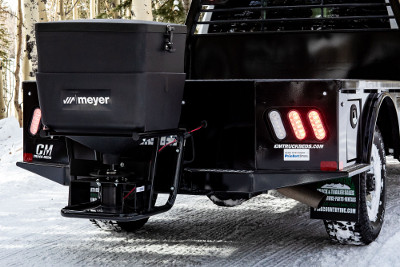 Meyer Base Line Tailgate Spreader
Meyer Base Line Tailgate Spreader
1. Area Size
Are you managing a small parking lot, a large shopping center, city streets or spans of highway? The area size will influence your choice of salt spreader. As a rule of thumb, you'll need to spread about 3 pounds of salt for every 1,000 square feet of area. Coverage varies with the type of spreader, from 0-18 feet for walk-behind models, and up to 30 feet for larger tailgate and insert spreaders. When looking to pre-treat prior to a storm, consider a liquid anti-icer system that distributes a brine mixture to prevent snow and ice from bonding to pavement. Brine is usually applied at a rate of 30-50 gallons per lane mile or acre.
2. Frequency of Use
Will the spreader or liquid system be used daily throughout winter or only during significant snow events? Frequent use may require a more durable model.
3. Type of Surface
Different surfaces may require different spreading capabilities. Sidewalks and driveways might need more precision than wider roads or parking areas.
4. Budget
Understanding your financial constraints will narrow down your options. Investing in the right equipment – even if it's more costly -- can save money in the long run by increasing efficiency.
Understanding the Types of Salt Spreaders & Deicers
Salt spreaders come in various types, each suited for different tasks and scales of operation. Choosing the right tool for the right job can make a significant difference in the success of the season. Here's a closer look:
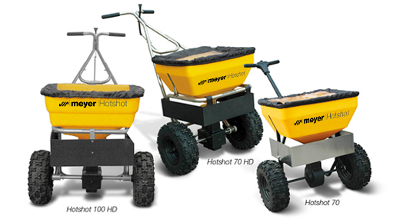 Meyer Walk-behind Spreaders
Meyer Walk-behind Spreaders
Walk-Behind Spreaders
Ideal for small areas like sidewalks and driveways. These spreaders are easy to maneuver and maintain. Meyer
walk-behind spreaders have a spread width of up to 18 feet.
Tailgate Spreaders
Mounted on the back of trucks, these are perfect for mid-sized areas such as parking lots, and offer a good balance between capacity, coverage area, and ease of use. Meyer
tailgate spreaders can achieve a spread width of up to 25 feet.
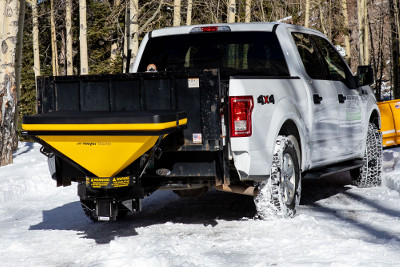 Meyer Blaster Tailgate Spreader
Meyer Blaster Tailgate Spreader
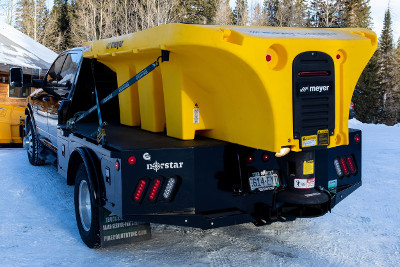 Meyer Crossfire Insert Spreader
Meyer Crossfire Insert Spreader
Insert Spreaders
These large,
hopper-style spreaders are designed for heavy-duty use, covering vast areas like highways and municipal roads. Meyer insert salt spreaders can cast material from 4 feet to 30 feet.
Dump Truck Spreaders
Turns your dump truck into a salt truck. Meyer
dump truck spreaders have an impressive spread width of up to 30 feet.
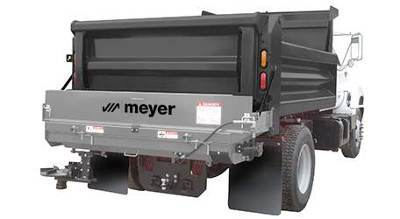 Meyer Base Line Dump Truck Spreader
Meyer Base Line Dump Truck Spreader
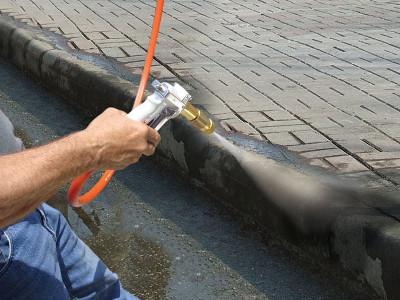 Meyer Liquid Anti-icer Applicator
Meyer Liquid Anti-icer Applicator
Liquid Anti-Icer / Deicing Systems
Liquid anti-icer or deicing systems fit into the bed of pickup trucks. These can be configured with a hitch mounted spray bar or can be used with a hose and spray gun for treating foot-traffic areas. Meyer
liquid systems are available with tank sizes from 100 to 400 gallons and come with a variety of hose options.
Understanding Specs and Features
Once you've nailed down the type of spreader or liquid system you need, it's time to wade through the various specifications and features for each, such as:
Capacity
For large areas or frequent snowfalls, a larger capacity reduces the number of refills needed, saving you time.
Materials
Ensure the spreader can handle the type of material you plan to use, whether rock salt, sand (or a combination of salt and sand), or a liquid de-icing brine mix.
Spreader Control and Accuracy
Control and precision are key when applying de-icing materials. Look for spreaders with adjustable flow rates and spread distances so you can apply the right amount of material exactly where needed.
Durability and Maintenance
Check that the spreader is made of quality materials like stainless steel and polyurethane for corrosion resistance. Ease of maintenance, accessible parts, and straightforward procedures save time and reduce downtime. Also, look for a good warranty.
Vehicle Compatibility
Ensure the spreader is compatible with your existing equipment. Whether it's a truck, ATV, or dump truck, the spreader should fit securely and operate effectively. Some models offer universal mounting systems for greater flexibility.
Controls
Modern salt spreaders come with a range of controls designed to enhance efficiency and user experience. Look for features like variable speed control, remote control operation, and hopper covers to keep material dry and clump-free.
Understanding What's Out There
Given the cost of the equipment, doing your homework is a must. Asking colleagues or other users with similar work scopes is a good idea. And, ask the
equipment dealer – dealers are knowledgeable about the equipment they sell and can steer you in the right direction. Reputable brands typically offer better customer service and
warranty options.
Conclusion
A well-chosen salt spreader or deicing system will not only save you time, money, and effort but will also help keep customers and the community happy and safe. With the right salt spreader, "if there is a problem, yo, you'll solve it" – like a pro, every time.